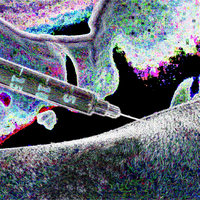| Clorgyline | |
|---|---|
| Salts [] | |
|---|---|
| %!s( | |
| Molecular structure via molpic based on CDK |
| Physical properties [] | |
|---|---|
| Molecular mass | 272.17 g/mol [1] |
| Predicted LogP | 4.2 [1] |
| Structural Identifiers [] | |
|---|---|
| Molecular formula | C13H15Cl2NO [1] |
| IUPAC name | 3-(2,4-dichlorophenoxy)-N-methyl-N-prop-2-ynylpropan-1-amine [1] |
| SMILES | CN(CCCOC1=C(C=C(C=C1)Cl)Cl)CC#C [1] |
| InChI | InChI=1S/C13H15Cl2NO/c1-3-7-16(2)8-4-9-17-13-6-5-11(14)10-12(13)15/h1,5-6,10H,4,7-9H2,2H3 [1] |
| InChIKey | BTFHLQRNAMSNLC-UHFFFAOYSA-N [1] |
Clorgyline
Clorgyline (also known as Clorgiline, Chlorgyline, Clorgilina, Clorgilinum, M and B 9302, M & B 9302, N-(3-(2,4-Dichlorophenoxy)propyl)-N-methyl-2-propynylamine, M&B 9302, N-(3-(2,4-dichlorophenoxy)propyl)-N-methylprop-2-yn-1-amine or 2-Propyn-1-amine, N-(3-(2,4-dichlorophenoxy)propyl)-N-methyl-) is a monoamine oxidase inhibitor substance of the phenol class.
Chemistry
Salts []
Clorgyline is typically found in the form of its hydrochloride salt.
Stereochemistry []
Clorgyline is a achiral mixture
See also []
External links []
References []
National Center for Biotechnology Information. PubChem Compound Summary for CID 4380, Clorgyline. Accessed July 20, 2025. https://pubchem.ncbi.nlm.nih.gov/compound/4380
U.S. Food and Drug Administration; National Center for Advancing Translational Sciences. Clorgyline. UNII: LYJ16FZU9Q. Global Substance Registration System. Accessed July 20, 2025. https://gsrs.ncats.nih.gov/ginas/app/beta/substances/LYJ16FZU9Q
 Anodyne
Anodyne